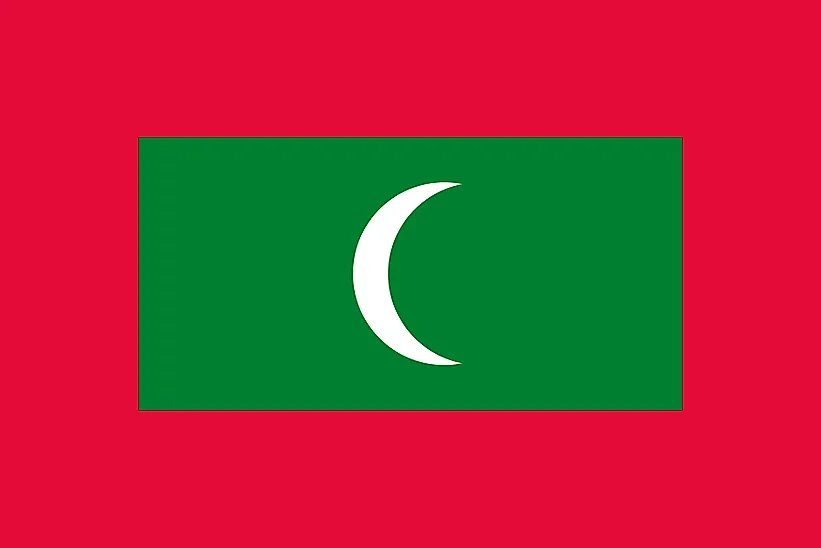
몰디브
| 대륙 | 아시아 |
| 자본 | 남성 |
| 인구 | 392,960 |
| GDP | $5.41억 |
| 1인당 GDP | $15,300 |
| 다이얼링 코드 | +960 |
| ISO 코드(2글자) | MV |
| ISO 코드(3글자) | MDV |
몰디브 소개
적도에 흩어져 있는 산호섬의 나라 몰디브에 오신 것을 환영합니다. 약 54만 명의 인구가 298제곱킬로미터의 육지와 9만 제곱킬로미터의 바다에 걸쳐 살고 있는 몰디브는 세계에서 가장 낮은 지대에 위치한 국가로, 놀라운 해양의 아름다움과 풍부한 문화유산을 간직하고 있습니다.
지리적 특징과 자연의 아름다움
몰디브의 지형은 1,192개의 산호 섬으로 이루어진 26개의 천연 환초로 이루어진 독특한 구조로 이루어져 있습니다. 몰디브는 깨끗한 백사장, 수정처럼 맑은 석호, 생동감 넘치는 산호초가 특징이며 해발 2.4미터 이상으로 솟아오른 땅이 없습니다.
이 풍경에는 광범위한 산호초 시스템, 해초밭, 맹그로브 생태계가 포함됩니다. 적도를 따라 위치한 이 나라는 열대 몬순 기후를 형성하여 풍부한 해양 생물 다양성을 지원합니다.
보호 지역에는 여러 해양 보호 구역과 바아 아톨의 유네스코 생물권 보호 구역이 있습니다. 환경 보호에 대한 국가의 노력으로 독특한 해양 생태계를 보존하기 위한 다양한 보존 이니셔티브가 추진되고 있습니다.
문화 유산과 전통
몰디브 문화는 남아시아, 아랍, 아프리카의 영향이 독특하게 혼합되어 있습니다. 몰디브의 유산에는 특히 산호석으로 지어진 고대 모스크와 전통 보트 건조 기술 등 독특한 건축 양식이 포함되어 있습니다.
전통 예술에는 현지 재료를 이용한 매트 짜기, 옻칠 작업, 전통 북(보두 베루) 제작 등이 있습니다. 음악과 춤의 전통은 다양한 문화적 영향을 반영하며, 전통 의식은 중요한 생활 행사와 축제를 기념합니다.
몰디브 요리는 생선, 코코넛, 다양한 향신료를 중심으로 마스리하(생선 커리)와 참치 요리와 같은 요리가 특징입니다. 공동체 생활과 해양 문화의 전통은 여전히 사회 생활의 중심입니다.
역사 여행
몰디브의 역사는 초기 불교 문명부터 이슬람 개종, 영국의 보호와 독립에 이르기까지 다양합니다. 고대 무역로를 따라 위치한 몰디브의 전략적 위치는 몰디브의 발전과 문화에 영향을 미쳤습니다.
중요한 시기에는 불교 시대, 1153년 이슬람으로의 개종, 포르투갈의 영향, 영국의 보호 기간, 1965년 독립 등이 있습니다. 현대 이슬람 민주주의 국가이자 관광지로의 발전은 이 나라의 적응력을 보여줍니다.
현대 경제 환경
오늘날 몰디브의 경제는 주로 관광과 어업에 기반을 두고 있습니다. 몰디브는 고급 리조트와 환경 지속 가능성에 중점을 둔 세계적으로 유명한 관광 산업을 발전시켰습니다.
최근 몰디브는 지속 가능한 개발, 기후 변화 적응, 경제 다각화에 중점을 두고 있습니다. 몰디브의 아름다운 자연과 전략적 위치는 최고의 관광지로서 몰디브의 입지를 뒷받침합니다.
국제 관계 및 글로벌 포지셔닝
몰디브는 지역 협력에 참여하면서 기후 변화 대응을 적극적으로 옹호하고 있습니다. 해수면 상승에 취약한 몰디브는 글로벌 환경 논의에서 강력한 목소리를 내고 있습니다.
알고 계셨나요?
- 몰디브는 약 9만 평방킬로미터에 걸쳐 섬이 흩어져 있는 세계에서 가장 분산된 국가인가요?
- 해수면 상승을 강조하기 위해 수중 내각 회의를 최초로 개최한 국가는 어디일까요?
- 몰디브의 전통 가옥은 못 하나도 사용하지 않고 지어졌다고요?
- 이 나라의 산호석 사원이 유네스코로부터 탁월한 보편적 가치를 인정받았나요?
결론
몰디브는 자연의 아름다움과 환경 문제가 독특하게 결합된 곳입니다. 산호초부터 문화 전통, 럭셔리 관광, 기후 보호에 이르기까지 몰디브는 기후 변화로 인한 실존적 위협을 해결하면서 계속 진화하고 있습니다. 지속 가능한 개발과 환경 보호에 중점을 두고 있는 몰디브는 전 세계적인 도전에 적응하면서 천국을 보존하기 위해 최선을 다하고 있습니다.





